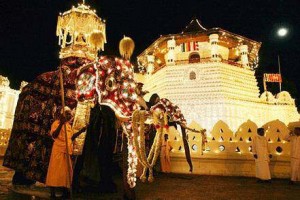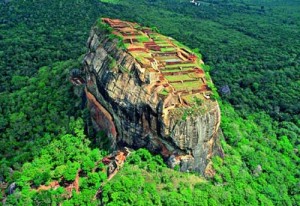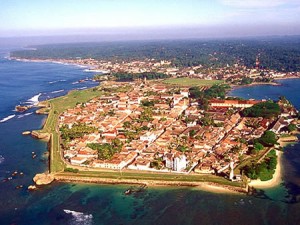
Sri Dalada Maligawa

Dalada perehera
Kandy is one of the most scenic places in Sri Lanka and is located between mountains and is elevated about 500 meters above sea level. Sri Dalada Maligawa was built within the royal palace complex which houses the only surviving relic of Buddha, a tooth, which is venerated by Buddhists. The relic has played an important role in the local politics since ancient times, It’s believed that whoever holds the relic holds the governance of the country, which caused the ancient kings to protect it with great effort. Kandy was the capital of the Sinhalese Kings from 1592 to 1815, fortified by the terrain of the mountains and the difficult approach. The city is a world heritage site declared by UNESCO in 1998. Monks of the two chapters of Malwatte and Asgiriya conduct daily ritual worship in the inner chamber of the temple, in annual rotation. The Temple of the Tooth Relic is famous for its annual parade known as ‘Esala Perahara’, which is the largest pageant of the Temple and takes place during the months of July and August each year and has over 100 elephants parading the city accompanied by dancers and drummer.
Sigiriya Rock Fortress

Sigiriya
Sigiriya, which has been presumed as the 8th Wonder of the World is a large ancient rock fortress and a palace ruin. It is surrounded by the remains of an extensive network of gardens, reservoirs, and other structures. A popular tourist destination, Sigiriya is also renowned for its ancient paintings, which are reminiscent of the Ajanta Caves of India. According to the chronicles as Mahavamsa the entire complex was built by King Kashyapa, and after the king’s death, it was used as a Buddhist monastery until 14th century.
Anuradhapura Ancient City
It lies 205 km (127 mi) north of the current capital Colombo in the North Central Province of Sri Lanka, on the banks of the historic Malvathu Oya. Anuradhapura was the first capital of Sri Lanka from the 4th century BC until the 11th century AD and is situated about 205km north from the current capital city of Colombo. Today the city is famous for its well preserved ruins of ancient Sri Lankan civilization, which include Dagobas, Monastic Buildings and Pokunas and is one of the eight World Heritage Sights of Sri Lanka. Just 13km away from this ancient city lay Mihintale one of Sri Lanka’s most prominent Buddhist sites, where Buddhism originated in the island in 247BC.
Galle – Dutch Fort

Galle fort
Galle is 119 km (74 mi) from Colombo. Galle was known as Gimhathiththa (although Ibn Batuta in the 14th century refers to it as Qali) before the arrival of the Portuguese in the 16th century, when it was the main port on the island. Galle reached the height of its development in the 18th century, before the arrival of the British, who developed the harbor at Colombo. The fort lighthouse dates back to 1848, is Sri Lanka’s oldest light station. The Galle Fort lies in the bay of Galle and was first built in 1588 by the Portuguese. A century after the Fort was established; the Dutch developed it to its current grandeur, which is now a UNESCO world heritage site.
Polonnaruwa
The second most ancient of Sri Lanka’s kingdoms, Polonnaruwa was first declared the capital city by King Vijayabahu I, who defeated the Chola invaders in 1070 CE to reunite the country once more under a local leader. While Vijayabahu’s victory and shifting of Kingdoms to the more strategic Polonnaruwa is considered significant, the real Polonnaruwa Hero of the history books is actually his grandson, Parakramabahu I. The city Polonnaruwa was also called as Jananathamangalam during the short Chola reign.
However, with the exception of his immediate successor, Nissankamalla I, all other monarchs of Polonnaruwa, were slightly weak-willed and rather prone to picking fights within their own court. They also went on to form more intimiate matrimonial alliances with stronger South Indian Kingdoms, until these matrimonial links superseded the local royal lineage and gave rise to the Kalinga invasion by King Magha in 1214 and the eventual passing of power into the hands of a Pandyan King following the Arya Chakrawarthi invasion of Sri Lanka in 1284. The capital was then shifted to Dambadeniya.
Today the ancient city of Polonnaruwa remains one of the best planned Archeological relic sites in the country, standing testimony to the discipline and greatness of the Kingdom’s first rulers.
Dambulla Cave Temple

Dambulla cave temple
Dambulla Cave Temple (also known as the Golden Temple of Dambulla) is a world heritage site (1991) in Sri Lanka, situated in the central part of the country. This site is situated 148 km (92 mi) east of Colombo and 72 km (45 mi) north of Kandy. It is the largest and best-preserved cave temple complex in Sri Lanka. There are five caves under a vast overhanging rock, which towers 160 meters over the surrounding plains. The caves house over 150 statutes of lord Buddha, god and goddesses as well as a few kings who have been vital in Sri Lanka’s history. The Buddha statues found inside the caves offer a large variety, both in term of size and attitude. Each of the ceilings in the five caves is covered with intricate and detailed religious paintings. One cave has over 1500 paintings of Buddha covering it.
Trincomalee
Trincomalee is a natural deep-water harbor that attracted great sea farers like Marco Polo, Ptolemy and Sea Traders in China and East Asia from the ancient times. The long and wide beaches offer surfing, scuba diving and fishing and whale watching. This sea town has the largest Dutch fortress of Sri Lanka and the oldest Hindu temple Tirukonesvaram Kovil in Sri Lanka.
Sinharaja Forest Reserve
Sinharaja Forest Reserve is a national park in Sri Lanka. It is of international significance and has been designated a Biosphere Reserve and World Heritage Site by UNESCO.
The hilly virgin rainforest, part of the Sri Lanka lowland rain forests ecoregion, was saved from the worst of commercial logging by its inaccessibility, and was designated a World Biosphere Reserve in 1978 and a World Heritage Site in 1989. The reserve’s name translates as Kingdom of the Lion.
The reserve is only 21 km (13 mi) from east to west, and a maximum of 7 km (4 mi) from north to south, but it is a treasure trove of endemic species, including trees, insects, amphibians, reptiles, birds and mammals.
Because of the dense vegetation, wildlife is not as easily seen as at dry-zone national parks such as Yala. There are no elephants, and the 15 or so leopards are rarely seen. The commonest larger mammal is the endemic Purple-faced Langur.